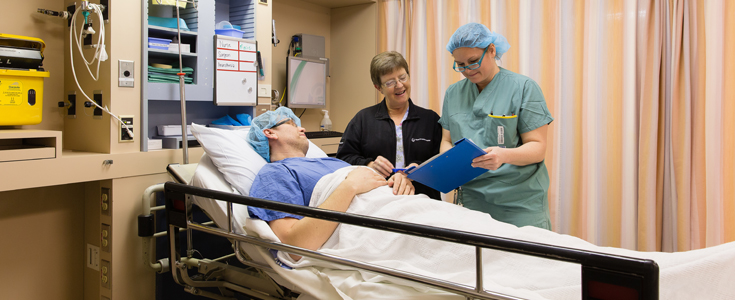Nurses Rita Picton and Kary McCorrie conduct a face-to-face report before transferring a patient to surgery
Safe transitions
By Karine Verot
Communications Coordinator,
St. Boniface Hospital
Transitions in care are pivotal moments in a person's journey at St-Boniface Hospital. The most significant transitions involve transferring a person from one care area to another. During transitions, information about the person, including their background and current situation, must be shared with the team taking over the person's care. Communication between care teams is critical to patient safety and timely transfers.
Intent on improving the safety and flow of patients, the Surgery Program began observing transfer practices and found opportunities to reduce errors.
"There is a great risk of information being missed during transitions of care," says Lance Barber, Surgery Program Director. "We thought face-to-face conversations would bring a different level of focus, commitment, and safety to our transfers."
Patients and families are encouraged to participate in the conversation during the face-to-face transitions. Nurses document any information that may be important, including the family's whereabouts during the surgery and how to contact them.
"Face-to-face transitions are three-way conversations between the sending nurse, the receiving nurse, and the patient or their family," says Brenda Van Walleghem, Program Team Manager, Surgery Program. "Patients are encouraged to share additional information or correct any misinformation."
Since implementing face-to-face transitions, patients are transferred faster with fewer gaps or delays in their care, improving the flow of patients throughout the Surgery Program. Patients are also receiving safer care with less duplication, error, and missed information.
It's an approach that has been adopted throughout the entire Hospital.
In looking for ways to improve and accelerate the admission and discharge of patients, nursing staff found 65 per cent of patients are discharged between noon and 5 p.m., creating a delay in admitting new patients.
Part of the challenge for nurses is caring for sick patients while preparing another patient for discharge, then arranging for a new patient to be admitted. The nursing team proposed the creation of an "Admission, Discharge, and Transfer (ADT)" nursing role. The ADT nurse is focused only on admitting and discharging patients and is not assigned to care for other patients.
"As an ADT nurse, I can have my full attention on the patient being discharged or welcomed," says Stephanie Nunes, Registered Nurse, E6 Medicine. "I don't have to worry about other patients and I am able to make this the best experience possible."
In the last year, the Medicine Program also introduced face-to-face transitions to increase safety. Now, the ADT nurse meets patients in the Emergency Department for face-to-face report at the patient's bedside. Together with the Emergency nurse, patient, and their family, the ADT nurse walks through a safety checklist. After sharing all required information, the ADT nurse accompanies the patient back up to the unit.
"We know when patients are admitted to the Hospital, they will have better outcomes if we can get them on the unit faster," says Sue-Ann Hobbs, Program Team Manager, E6 Medicine. "Increasing communication with nurses in the Emergency Department improves the admission process for patients and staff."
Thanks to the new ADT role, discharges are happening earlier in the day, patients are being admitted to the unit sooner and according to Nunes, patients are noticing a difference.
"Patients no longer feel like they are just a chart when we are meeting with them face-to-face in Emergency. Their anxiety decreases and it's a much more personal experience for our patients.

